How to use the SIN function
The SIN function calculates the sine of an angle.
What's on this page
1. Introduction
What is the sine?
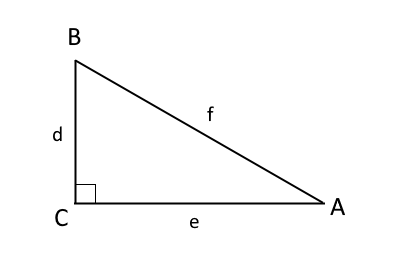
A, B and C are angles, C is 90° or π/2 radians. One of the angles must be 90° (right angle triangle), in the example above C is 90° or π/2 radians.
d, e, and f are lengths of the sides of the triangle. Side d and e are perpendicular to each other, meaning the angle between them are 90° or π/2 radians.
SINE A is equal to the ratio between sides d and f, this is only true if the triangle is a right-angled triangle.
SINE A = d/f
What is the sine ratio?
The sine ratio is the opposite side divided by the hypotenuse of a right triangle: sine = opposite side / hypotenuse

The following sine ratio is based on the image above:
SINE A = d/f
Side d is the opposite side based on angle A. Side f is the hypotenuse.
SINE B = e/f
Side e is the opposite side based on angle B. Side f is the hypotenuse.
What is the angle θ?
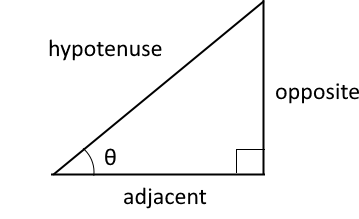
The Greek letter theta (θ) is commonly used to represent an unknown angle in a right triangle.
What is a right triangle?
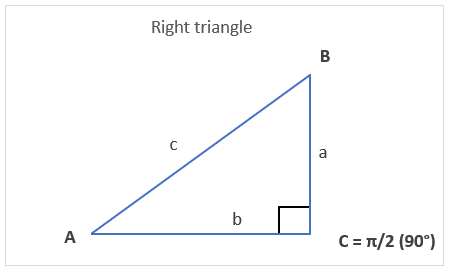
A right triangle is a type of triangle that contains one internal angle measuring 90 degrees or π/2 radians (a right angle).
What are radians?
Radians are a unit used to measure angles. An angle of 1 radian has an arc length equal to the circle's radius.
What is the relationship between the number pi and radians?
Radians measure angles by the length of the arc they make in a circle rather than degrees. The full circumference of any circle is 2π multiplied by the circle's radius (2πr).
Since the circumference goes all the way around a circle, that means the full circle measures 2π radians. Half a circle would be π radians (half of 2π). A quarter circle is 2π/4 = π/2 radians. An eighth of a circle is 2π/8 = π/4 radians.
Excel has a function that returns the number pi: PI function
What is an arc?
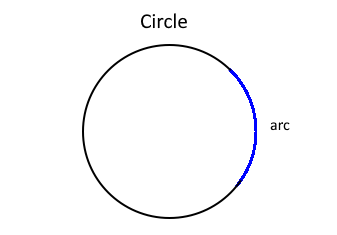
An arc is a curved segment of a circle's circumference, it is a portion of the circle's curve, defined by two endpoints.
In other words, an arc is formed by two radii intersecting the circumference and the enclosed edge between them.
What is a circle's radius?
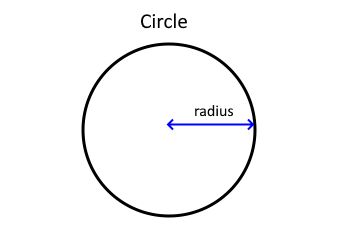
The radius of a circle is the distance from the center point to any point on the circle's edge or circumference.
What is radii?
The plural form of the word "radius".
What is the Pythagorean theorem?
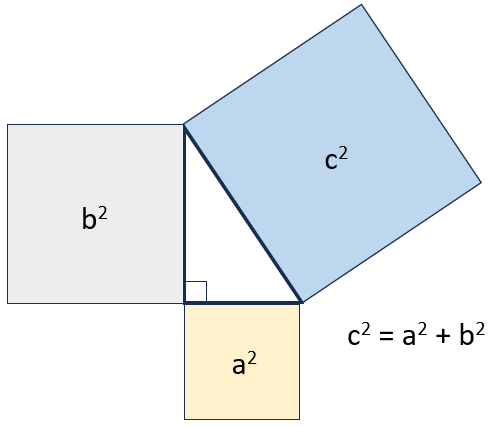
The Pythagorean theorem is a mathematical relationship between the sides of a right triangle. In a right triangle, the square of the hypotenuse is equal to the sum of the squares of the other two sides.
a2 + b2 = c2
a and b are the lengths of the legs of the triangle
c is the length of the hypotenuse
For example, in a triangle with legs 5 and 2:
√(52 + 22) = √(25 + 4) = √29
The hypotenuse is √29
What are the main trigonometric functions?
| Function | Domain (input) | Range (output) |
| sin(x) | All real numbers | (-1, 1) |
| cos(x) | All real numbers | (-1, 1) |
| tan(x) | All real numbers except multiples of π/2 | (-∞, ∞) |
| sec(x) | All real numbers except multiples of π | (1, ∞) U (-∞, -1) |
| csc(x) | All real numbers except integer multiples of π | (-∞, -1) U (1, ∞) |
| cot(x) | All real numbers except integer multiples of π | (-∞, ∞) |
2. Syntax
SIN(number)
| number | Required. The radian angle you want to know the sine of. |
3. Example
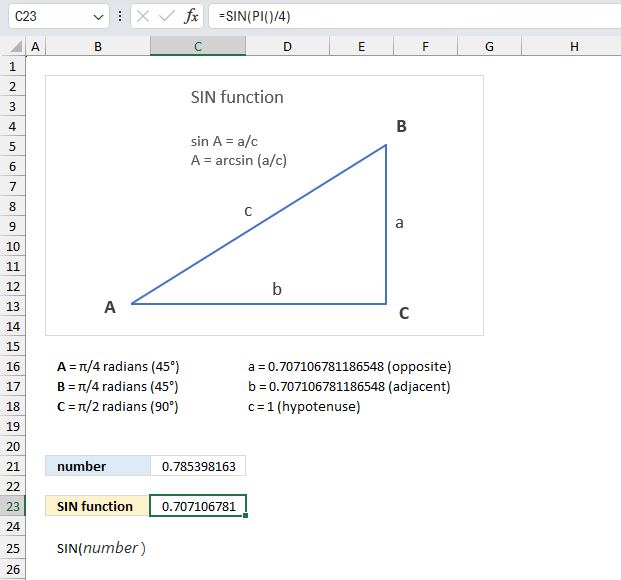
Calculate the sine of π/4 radians?
The argument is:
- number: PI()/4 represents π/4 radians or 0.785398163397448 radians.
Formula in cell C3:
Cell C3 returns the sine ratio which in this example is 0.707106781186548.
Determine the hypotenuse if the opposite side is 1 and the angle is π/4?
Sine A = a/c
Sine π/4 = 0.707106781186548
0.707106781186548 = a/c
If the ratio 0.707106781186548 is equal to a/c then 0.707106781186548=1/c
c=1/0.707106781186548
c=1.41421356237309
c=√2
You can also calculate the hypotenuse using Pythagoras theorem which states that the squared hypotenuse is equal to the sum of the squared opposite side and the adjacent side. c2 = a2 + b2
If a = 1 then b must also be equal to 1, because the angle is π/4 or 45 degrees.
c2 = 12 + 12
c2 = 2
c = √2
c=1.41421356237309
4. How to use degrees in the SIN function
Use the RADIANS function to convert degrees to radians.
Formula in cell C3:
5. How to plot a sine wave or sinusoidal wave on a chart
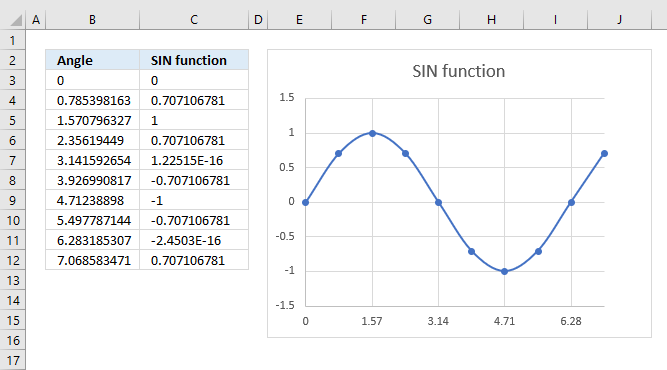
The steps below describe in great detail how to graph a sine wave in an Excel chart.
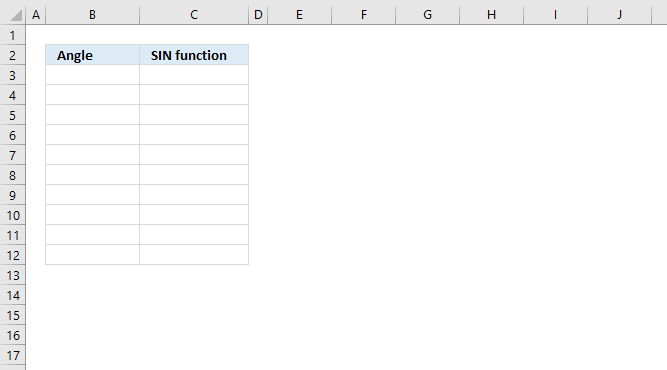
The SIN function requires you to use radians in the function argument. Select cell B3 and type 0 (zero) then press Enter.
Type in cell B4:
Press Enter. Copy cell B4 and paste to cells below as far as needed.
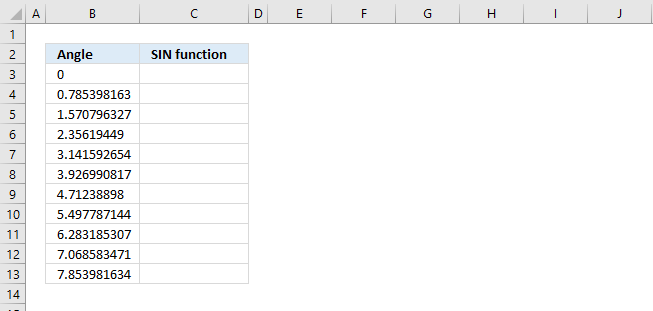
Select cell C3. Type
Press Enter.
5.1 How to quickly copy a formula and paste to cells below
Double press with left mouse button on the black dot in the lower right cell corner, see the animated image below.
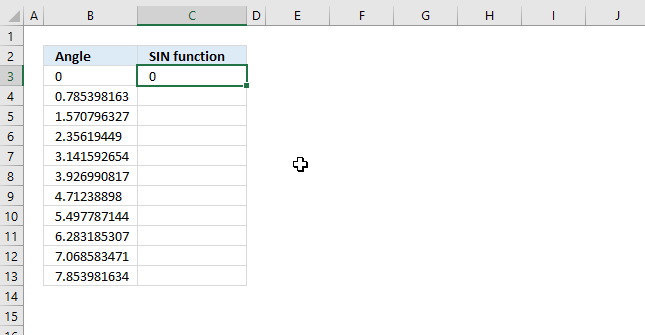
This will copy cell C3 to cells below as far as needed based on values in adjacent column B.
5.2 How to insert a Scatter chart with Smotth Lines and Markers
Select cell range B3:C12 and go to tab "Insert" on the ribbon.
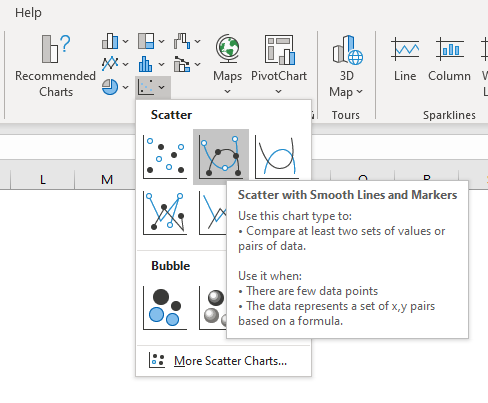
Press with left mouse button on the "Scatter" button, a pop-up menu appears. Press with left mouse button on "Scatter with Smooth Lines and Markers" button, see image above.
5.3 How to reposition a chart?
The chart appears on your current worksheet, press and hold with the left mouse button on the chart. Drag with mouse to move the chart to the desired location. Release the left mouse button when the new location is reached.
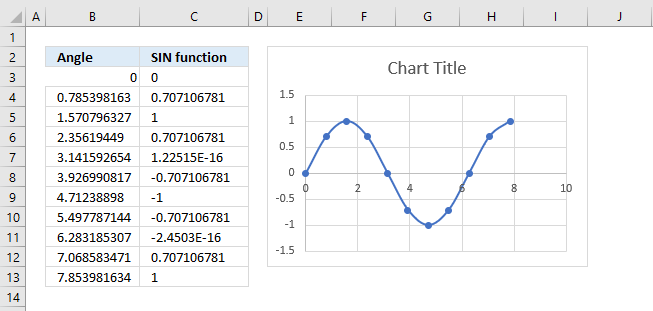
5.4 How to change the x-axis location in an Excel chart?
Doublepress with left mouse button on the y-axis to quickly show axis chart settings.

Press with left mouse button on the radio button "Axis value" below "Horizontal axis crosses". Type -1.5 in the field next to the radio button, see image above. Press Enter. This moves the x-axis below the gridlines.
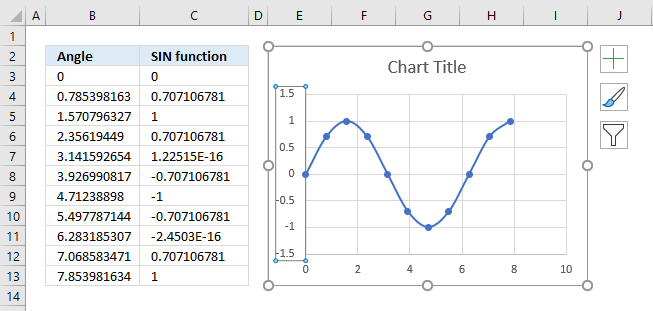
5.5 How to change the chart x-axis range?
The x-axis ranges from 0 to 10, if you want to only show values from 0 to the last value in column B then copy cell B13.
Double press with left mouse button on the y-axis to open the axis settings.
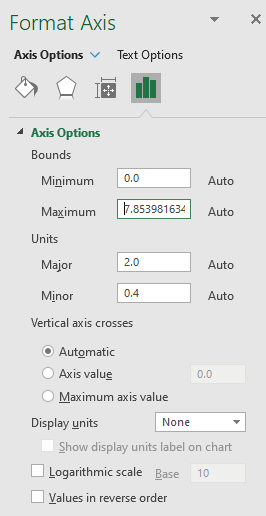
Type the maximum number you want to be shown in Bounds - Maximum, in this case, paste the value you copied in the previous step.
5.6 Explaining formula in cell B4
I recommend the "Evaluate Formula" tool when trying to understand or troubleshoot Excel formulas. Select cell B4.
Go to tab "Formulas" on the ribbon, then press with left mouse button on the "Evaluate Formula" button. The following dialog box appears, see image below.
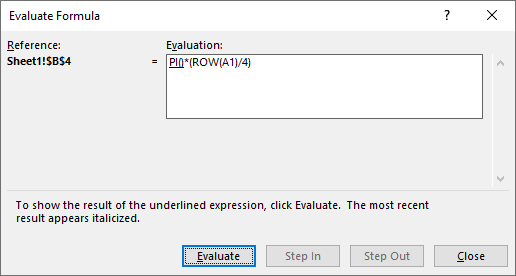
The dialog box allows you to see the formula and the part that is going to be evaluated (underlined expression). The most recent calculation is italicized, however, the image above shows the first calculation step. No expression is italicized because there has not been any calculation yet.
Press with left mouse button on the "Evaluate" button located on the dialog box to calculate the next part of the formula.
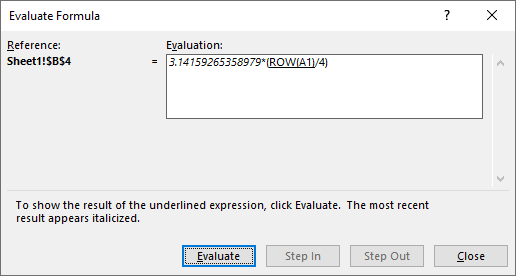
The image above shows the result of PI() italicized and ROW(A1) is underlined meaning it will be calculated in the next step.
Step 1 - Create a sequence
The ROW function allows you to create a sequence or series of numbers based on a relative cell reference, in this case, A1.
A relative cell reference changes when you copy the cell and paste it to another cell. This makes the formula return a new value in each cell.
The ROW function returns the row number from a cell reference. Cell A1 is on row 1.
ROW(A1)
returns 1.
Step 2 - Divide with 4
This step divides the row number with four.
ROW(A1)/4
becomes
1/4
and returns 0.25.
Step 3 - Multiply with pi
The PI function returns the PI number.
PI()*(ROW(A1)/4)
becomes
PI()*0.25
becomes
3.141592654*0.25
and returns 0.785398163 in cell B4.
6. How to change sine wave amplitude
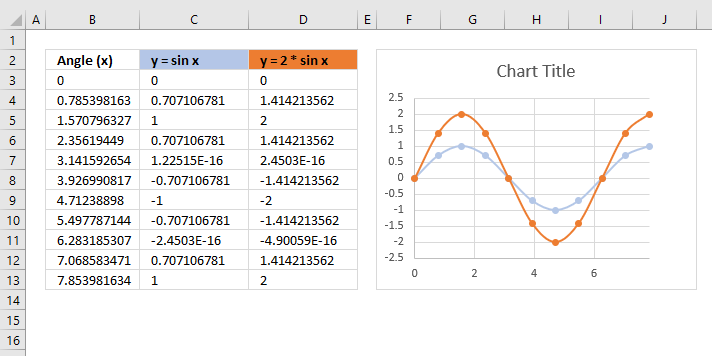
The general form of the Sin wave is y = A*Sin(B*(x-C))+D
Constant A in the formula above changes the amplitude or height of the sine wave. The image above shows two different sine waves, a blue one and an orange one.
The orange sine wave has an amplitude or height of 2 and the blue one has an amplitude of 1.
Formula in cell C3:
Formula in cell D3:
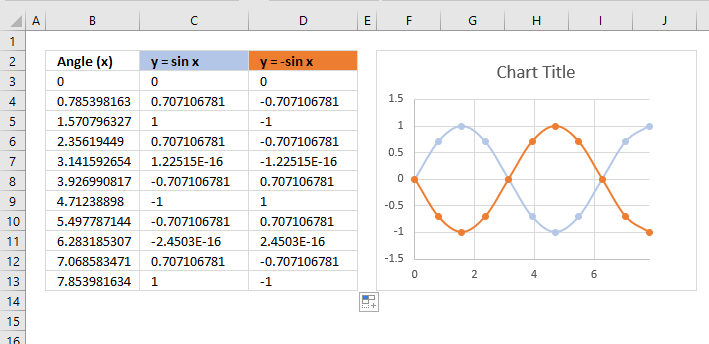
The sine wave is mirrored if you change constant A to -1.
7. How to change the sine wave period
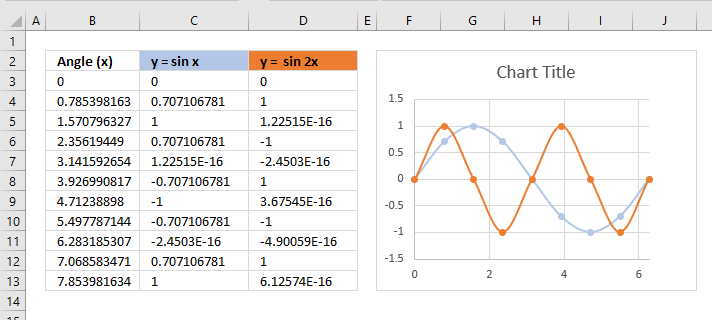
The general form of the Sin wave is y = A*Sin(B*(x-C))+D
Constant B changes the period, the chart above shows two sine waves. The blue sine wave completes a cycle in 2π or 360°, however, the orange sine wave completes two cycles in 2π or 360°.
Formula in cell C3:
Formula in cell D3:
8. How to change the sine wave midline
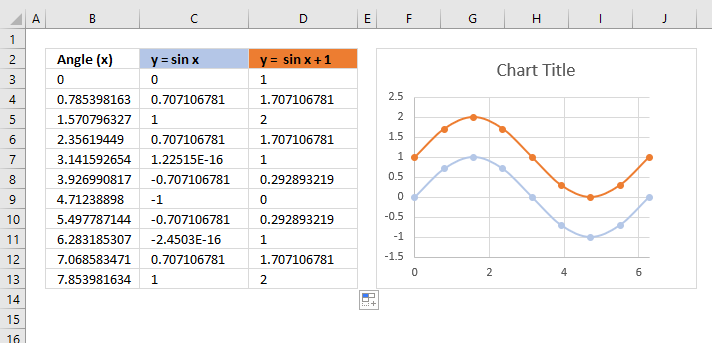
The general form of the Sin wave is y = A*Sin(B*(x-C))+D
Constant D lets you change the midline which is the centerline in which the sine wave oscillates back and forth. The midline is horizontal and is right in between the minimum and maximum sine function values.
Formula in cell C3:
The blue sine wave in column C has a maximum value of 1 and a minimum value of -1, the midline is 0 (zero).
Formula in cell D3:
The orange sine wave in column D has a maximum value of 2 and a minimum value of 0, the midline is 1 (zero).
9. How to use the SIN function with a right or right-angled triangle

A, B and C are angles, C is 90°, shown in the image above. A + B + C = 180°. One of the angles must be 90° (right angle triangle), in the example above C is 90°.
d, e, and f are lengths of the sides of the triangle. Side d and e are perpendicular to each other, meaning the angle between them are 90°.
SIN A = d/f
SIN A is equal to the ratio between sides d and f, this is only true if the triangle is a right-angled triangle.
10. Function not working

The SIN function returns
- #VALUE! error if you use a non-numeric input value.
- #NAME? error if you misspell the function name.
- propagates errors, meaning that if the input contains an error (e.g., #VALUE!, #REF!), the function will return the same error.
10.1 Troubleshooting the error value

When you encounter an error value in a cell a warning symbol appears, displayed in the image above. Press with mouse on it to see a pop-up menu that lets you get more information about the error.
- The first line describes the error if you press with left mouse button on it.
- The second line opens a pane that explains the error in greater detail.
- The third line takes you to the "Evaluate Formula" tool, a dialog box appears allowing you to examine the formula in greater detail.
- This line lets you ignore the error value meaning the warning icon disappears, however, the error is still in the cell.
- The fifth line lets you edit the formula in the Formula bar.
- The sixth line opens the Excel settings so you can adjust the Error Checking Options.
Here are a few of the most common Excel errors you may encounter.
#NULL error - This error occurs most often if you by mistake use a space character in a formula where it shouldn't be. Excel interprets a space character as an intersection operator. If the ranges don't intersect an #NULL error is returned. The #NULL! error occurs when a formula attempts to calculate the intersection of two ranges that do not actually intersect. This can happen when the wrong range operator is used in the formula, or when the intersection operator (represented by a space character) is used between two ranges that do not overlap. To fix this error double check that the ranges referenced in the formula that use the intersection operator actually have cells in common.
#SPILL error - The #SPILL! error occurs only in version Excel 365 and is caused by a dynamic array being to large, meaning there are cells below and/or to the right that are not empty. This prevents the dynamic array formula expanding into new empty cells.
#DIV/0 error - This error happens if you try to divide a number by 0 (zero) or a value that equates to zero which is not possible mathematically.
#VALUE error - The #VALUE error occurs when a formula has a value that is of the wrong data type. Such as text where a number is expected or when dates are evaluated as text.
#REF error - The #REF error happens when a cell reference is invalid. This can happen if a cell is deleted that is referenced by a formula.
#NAME error - The #NAME error happens if you misspelled a function or a named range.
#NUM error - The #NUM error shows up when you try to use invalid numeric values in formulas, like square root of a negative number.
#N/A error - The #N/A error happens when a value is not available for a formula or found in a given cell range, for example in the VLOOKUP or MATCH functions.
#GETTING_DATA error - The #GETTING_DATA error shows while external sources are loading, this can indicate a delay in fetching the data or that the external source is unavailable right now.
10.2 The formula returns an unexpected value

To understand why a formula returns an unexpected value we need to examine the calculations steps in detail. Luckily, Excel has a tool that is really handy in these situations. Here is how to troubleshoot a formula:
- Select the cell containing the formula you want to examine in detail.
- Go to tab “Formulas” on the ribbon.
- Press with left mouse button on "Evaluate Formula" button. A dialog box appears.
The formula appears in a white field inside the dialog box. Underlined expressions are calculations being processed in the next step. The italicized expression is the most recent result. The buttons at the bottom of the dialog box allows you to evaluate the formula in smaller calculations which you control. - Press with left mouse button on the "Evaluate" button located at the bottom of the dialog box to process the underlined expression.
- Repeat pressing the "Evaluate" button until you have seen all calculations step by step. This allows you to examine the formula in greater detail and hopefully find the culprit.
- Press "Close" button to dismiss the dialog box.

There is also another way to debug formulas using the function key F9. F9 is especially useful if you have a feeling that a specific part of the formula is the issue, this makes it faster than the "Evaluate Formula" tool since you don't need to go through all calculations to find the issue.
- Enter Edit mode: Double-press with left mouse button on the cell or press F2 to enter Edit mode for the formula.
- Select part of the formula: Highlight the specific part of the formula you want to evaluate. You can select and evaluate any part of the formula that could work as a standalone formula.
- Press F9: This will calculate and display the result of just that selected portion.
- Evaluate step-by-step: You can select and evaluate different parts of the formula to see intermediate results.
- Check for errors: This allows you to pinpoint which part of a complex formula may be causing an error.
The image above shows cell reference C21 converted to hard-coded value using the F9 key. The SIN function requires numerical values which is not the case in this example. We have found what is wrong with the formula.
Tips!
- View actual values: Selecting a cell reference and pressing F9 will show the actual values in those cells.
- Exit safely: Press Esc to exit Edit mode without changing the formula. Don't press Enter, as that would replace the formula part with the calculated value.
- Full recalculation: Pressing F9 outside of Edit mode will recalculate all formulas in the workbook.
Remember to be careful not to accidentally overwrite parts of your formula when using F9. Always exit with Esc rather than Enter to preserve the original formula. However, if you make a mistake overwriting the formula it is not the end of the world. You can “undo” the action by pressing keyboard shortcut keys CTRL + z or pressing the “Undo” button
10.3 Other errors
Floating-point arithmetic may give inaccurate results in Excel - Article
Floating-point errors are usually very small, often beyond the 15th decimal place, and in most cases don't affect calculations significantly.
Useful links
'SIN' function examples
Table of Contents How to use the IMABS function How to use the IMAGINARY function How to use the IMARGUMENT […]
Table of Contents How to use the DEC2BIN function How to use the DEC2HEX function How to use the DEC2OCT […]
Functions in 'Math and trigonometry' category
The SIN function function is one of 62 functions in the 'Math and trigonometry' category.
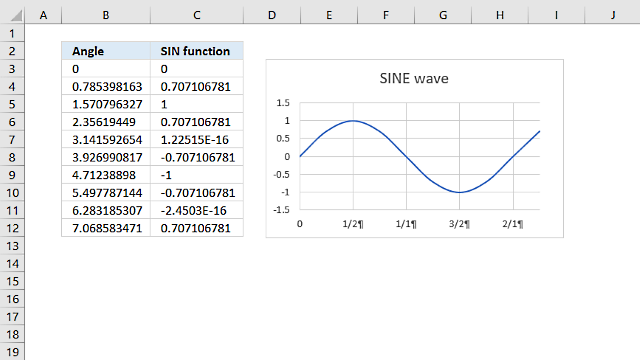
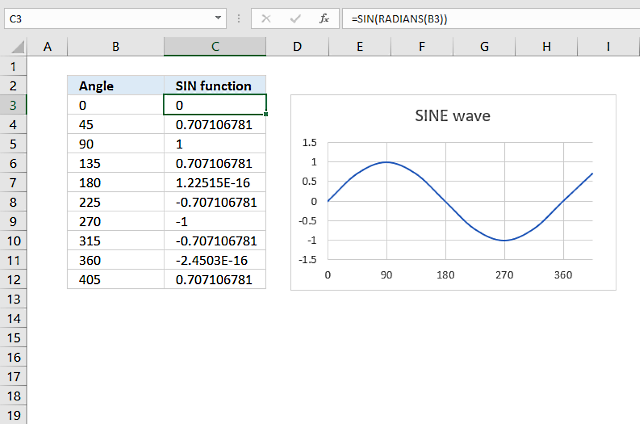
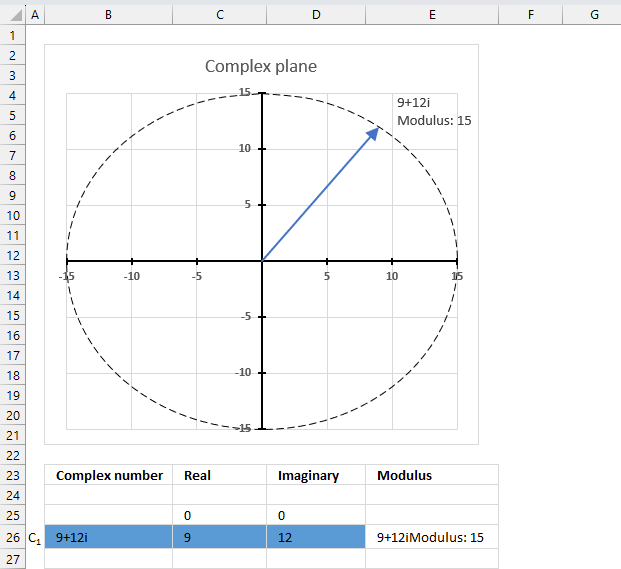
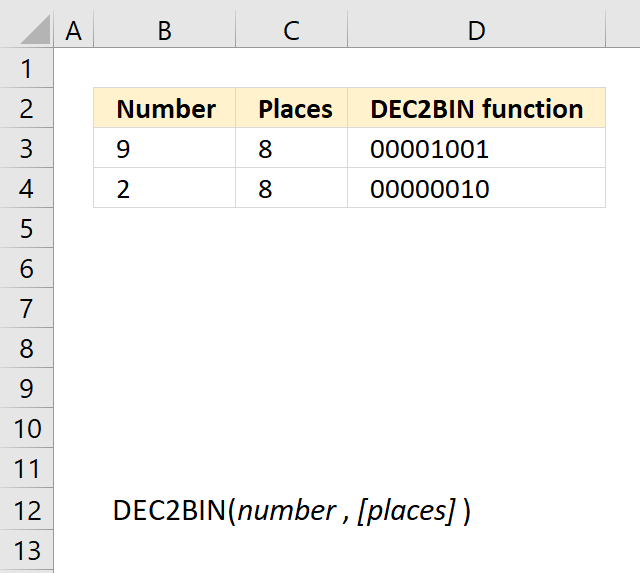
How to comment
How to add a formula to your comment
<code>Insert your formula here.</code>
Convert less than and larger than signs
Use html character entities instead of less than and larger than signs.
< becomes < and > becomes >
How to add VBA code to your comment
[vb 1="vbnet" language=","]
Put your VBA code here.
[/vb]
How to add a picture to your comment:
Upload picture to postimage.org or imgur
Paste image link to your comment.
Contact Oscar
You can contact me through this contact form